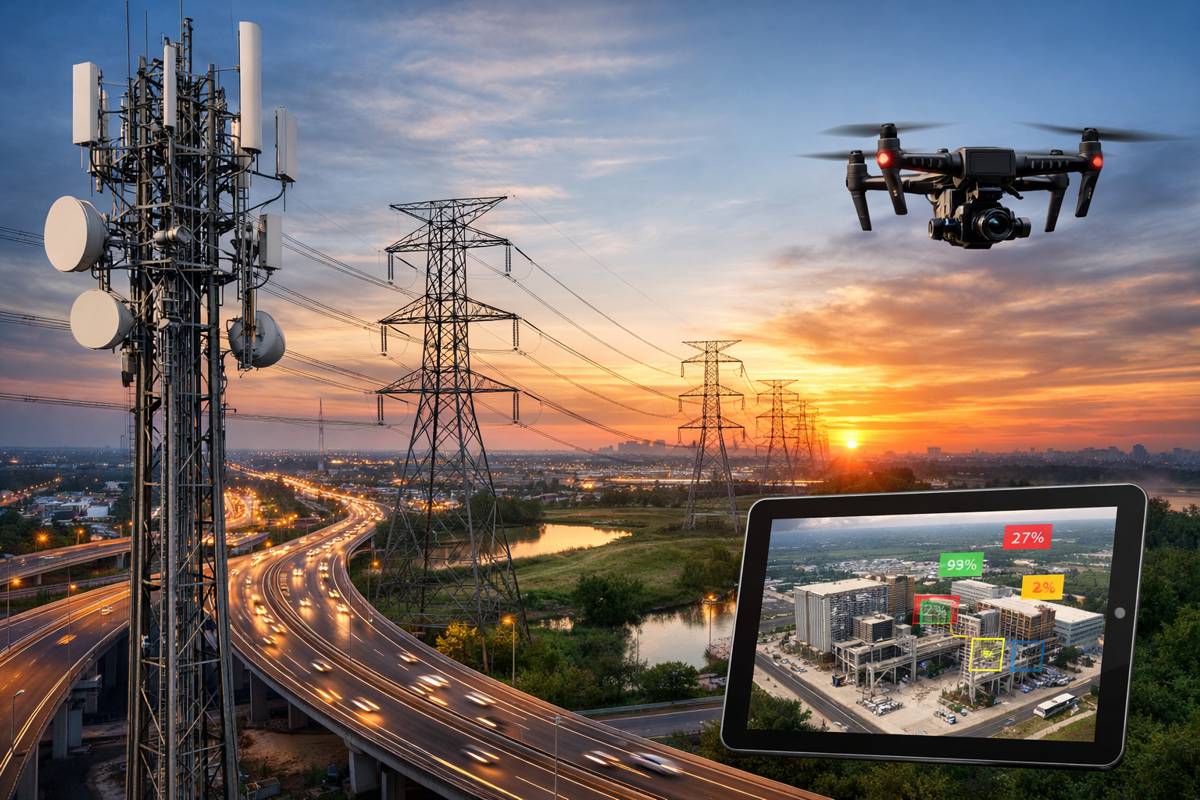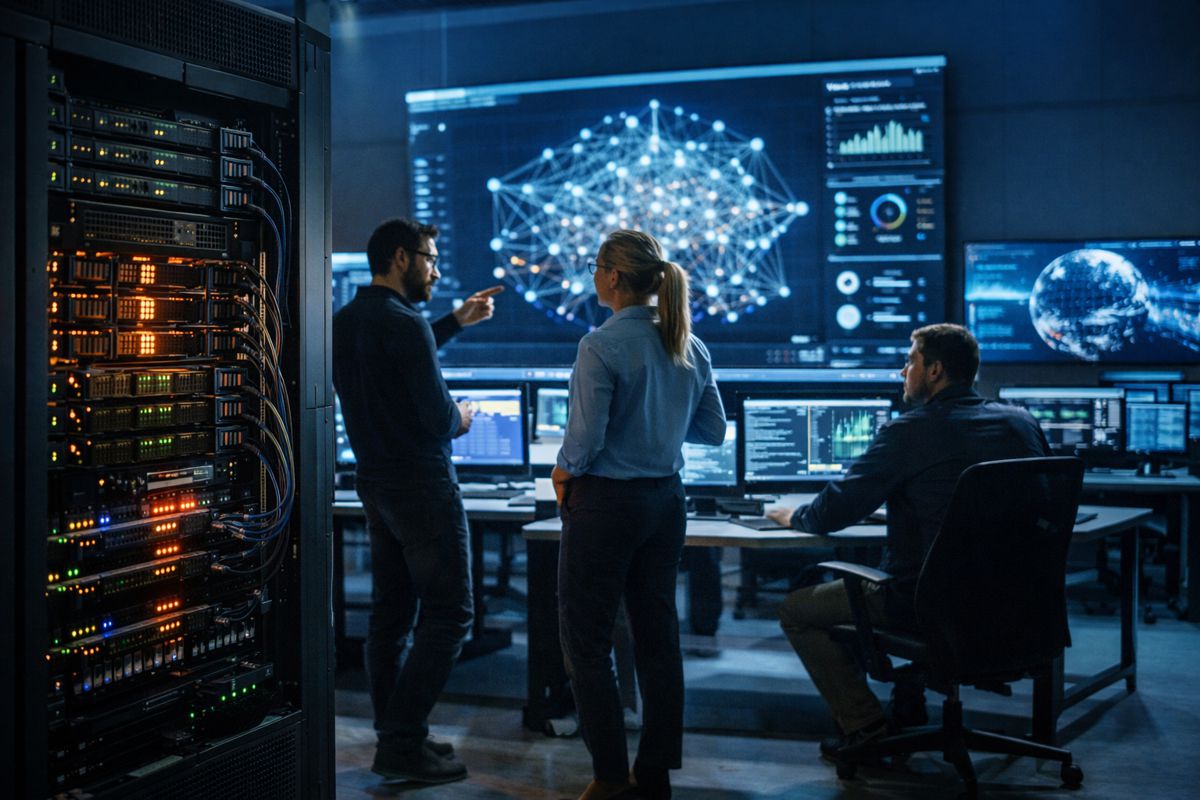The highly effective and affordable highway ITL Interchange
Modern highway interchanges and other heavy traffic roads interchanges have to ensure the highest possible traffic safety and capacity. Most of these interchanges are located on the outskirts of major cities and also in urban areas where the size of the interchanges is conditioned by the space available. The financial aspect, which defray the costs of construction and maintenance of the interchange, is also very important.
There are many different types of interchanges. Each type of it has some advantages and disadvantages in a particular surrounding. We present a new solution for the highway interchange, which in most comparisons achieves very good and in many things the best results.
The characteristic of this interchange is that in the area of the interchange the opposite carriageways of a single highway (roads) are separated to the extent that in the middle there is space for left directional ramps. That’s where the name comes from: Inside Turning Left Interchange (ITL Interchange).
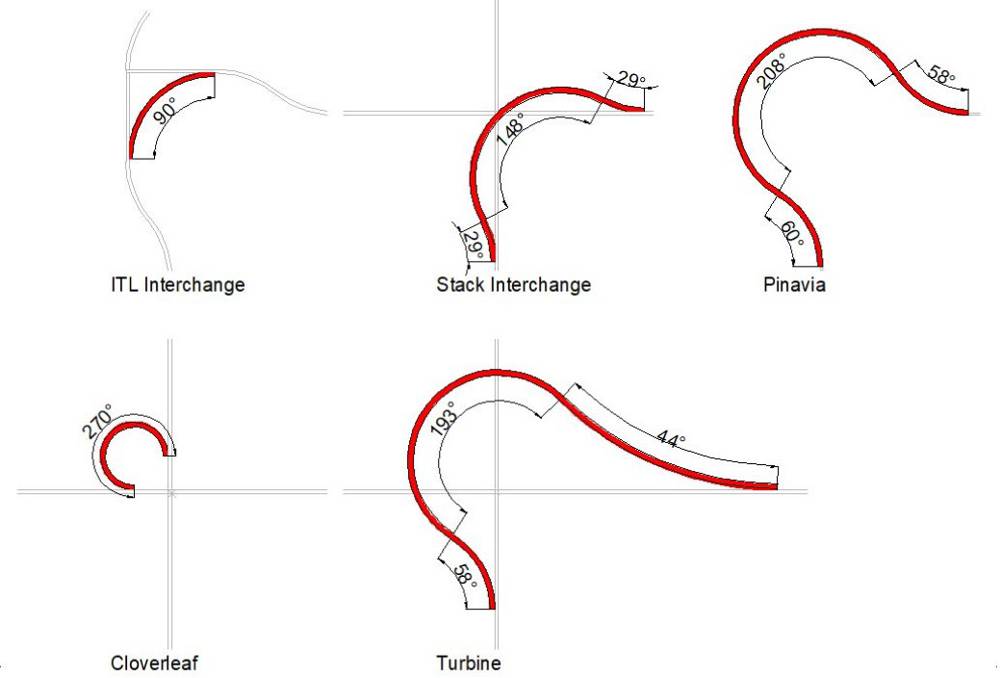
The directions described apply to countries where the right-hand drive rule applies. In the case of driving on the left, the situation is reversed. There are right directional ramps in the middle of the intersection.
ITL Interchange should be used for four-way interchanges or other heavy traffic roads junction in order to increase the capacity and traffic safety at the crossing point. ITL Interchange is suitable for interchanges where traffic is approximately evenly distributed in all traffic directions. It is less suitable for roads where most vehicles drive straight ahead and only a few vehicles turn right or left. ITL Interchange has no conflict points.
ITL Interchange left turning ramps are much shorter than all other known solutions for interchanges. The interchange is built in two levels. These two facts significantly lower the cost of construction.
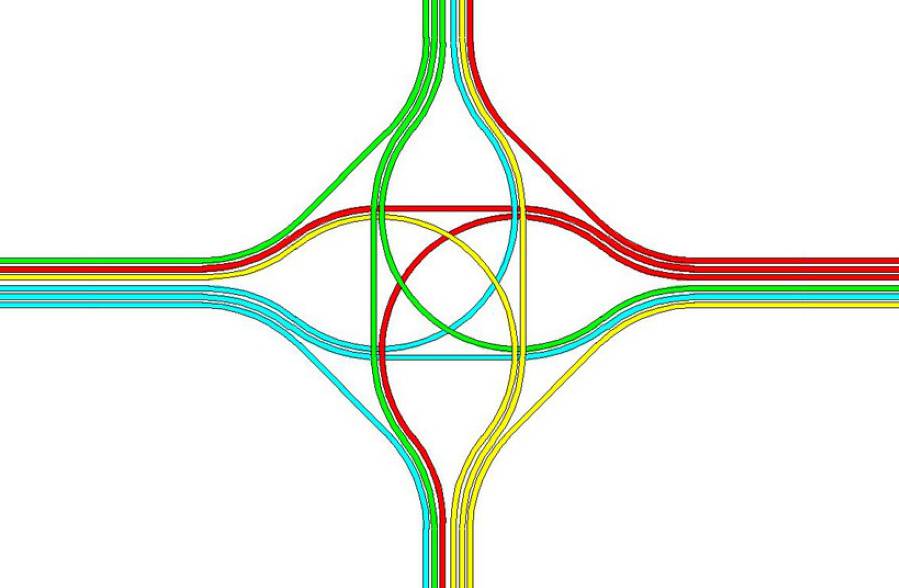
Designing the ITL Interchange
We have two big challenges in designing Itl Interchange. The first challenge is vehicles sorting before the interchange. An even bigger challenge is level change of the slip road for turning to the left.
Vehicles sorting before the interchange
At a sufficient distance before the interchange on the highway (at least 1500 m), it is necessary to limit the speed and inform the drivers with the vertical and horizontal signaling which lane leads to which traffic direction. This also helps avoid unnecessary weaving within the interchange and prepare drivers for timely sorting.
The ITL Interchange is suitable where traffic is approximately evenly distributed in all directions. The inner lanes lead to left directional ramps. Vehicles that turn to the left do not change the lane. Vehicles driving straight or turning to the right, move to the right-hand lanes before the interchange.
Level change of the slip road for turning to the left
Left directional ramp has to remain on the unchanged level until it crosses both of the left directional ramps at the opposite level. This length is about 2/3 of the entire length of the directional ramp. Therefore, there is a very short distance to pass to come to the opposite altitude level. Sharp vertical convex and concave curves allow significantly lower speeds than allowed by a horizontal turn. In order to mitigate vertical curves, we use a trick to slightly raise the level of both roads in the diagonal corners. In the other two diagonal corners, the level of the roads should be slightly lowered. The straight lane must also be adapted to these level changes.
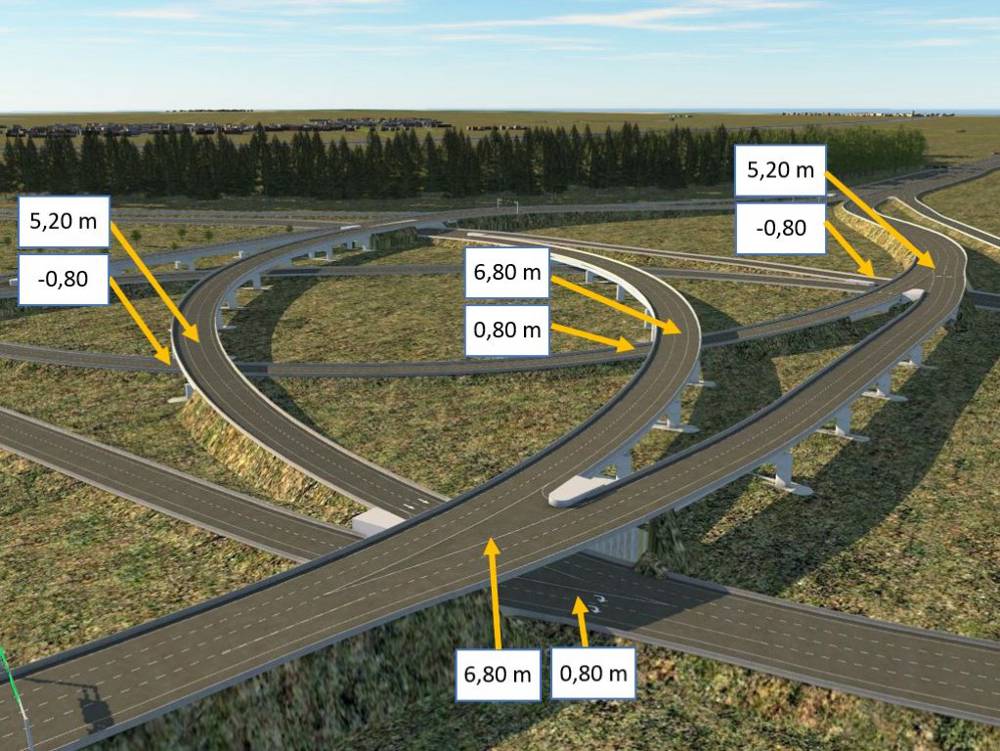
Practical calculation has shown that a level rise of about 80 cm on one side and a level drop of about 80 cm on the other side is sufficient.
Geometry comparison of interchanges
Comparison is made for interchanges which allow higher speeds also on the left directional ramps and thus ensure greater traffic capacity. These interchanges also have no conflict points. This group includes: Stack Interchange, Turbine and Pinavia.
There are also other types of interchanges. However, at these interchanges, a crucial speed reduction is required when turning to the left. These interchanges are: Cloverleaf, Contraflow Left, Diverging Windmill… Due to the low cost of construction, the Cloverleaf is included in the comparison. However, for the same area of the entire interchange as ITL Interchange, the Cloverleaf has a much lower speed limit for turning to the left. The Cloverleaf also has conflicting points, while other interchanges do not.
Comparison is made for interchanges with horizontal radius for the left directional ramp R=250 m. This radius allows driving at a speed of 80 km/h. In case of the Cloverleaf on the same area, horizontal radius is R=100 m for turning to the left.

Parameters
- Radius of the horizontal circular curve for left directional ramps R=250 m (Cloverleaf R=100 m).
- Maximum transverse inclination 7%.
- Vertical rounding with a convex radius of 4000 m and a concave radius of 3000 m.
- Maximum longitudinal inclination 6%.
- Altitude difference between individual levels 6 m.
- Speed limit 80 km/h.
Results
Stack Interchange, Turbine and Cloverleaf have a completely straight lines when driving through. ITL Interchange has a slightly longer distance due to the separation of carriageways. Pinavia has an even longer distance because lanes run along the circle.
Construction for right directional ramps is similar in all cases. ITL Interchange and Stack Interchange have the shortest length of ramps. The Cloverleaf and Pinavia have an approximately double length, and Turbine, due to its size, has about a triple length according to the most favourable variants.
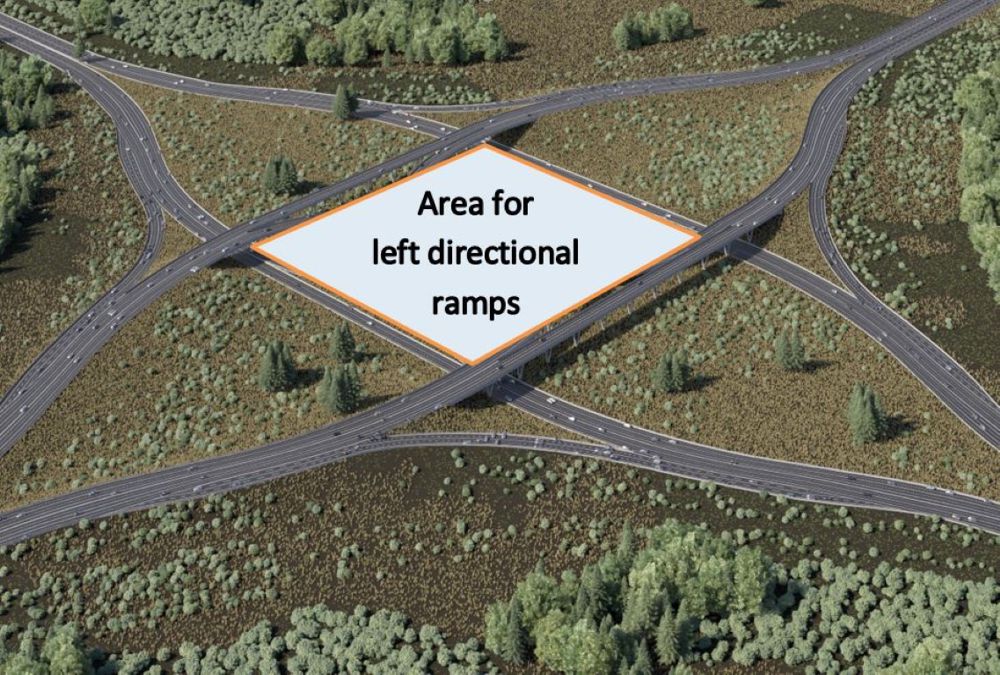
However, construction for left directional ramps totally differs. There are the greatest differences between compared interchanges. Ramps mostly lead over the overpasses. ITL Interchange has an extremely short length of ramps. A little longer distance is in the Cloverleaf, but due to the small radius, there is a lower speed limit. The distance is greater by factor 2 on Stack Interchange and more than by factor 3 on Pinavia and Turbine.
Cloverleaf has the shortest length of overpasses. However, it has lower speed limits for turning to the left and some conflict points. At other compared interchanges, ITL Interchange has the shortest length of overpasses. The distance of overpasses is greater approximately by factor 2,5 on Stack Interchange and Turbine. Pinavia has by far the highest length of overpasses. Compared with ITL Interchange, the factor is more than 5.
The results of the geometric comparison are shown in the table below:
| ITL Interchange | Stack Interch. | Turbine | Pinavia | Cloverleaf(*1) | |
| Area of interchange (ha) (*2) | 33,5 | 18,5 | 58 | 33,5 | 33,5 |
| Number of levels | 2 | 4 | 2 | 2 | 2 |
| Road distance | |||||
| Road distance straight (m) | 1.360 | 1.300 | 1.300 | 1.420 | 1.300 |
| Road distance right (m) | 330 | 390 | 1.070 | 680 | 590 |
| Road distance left (m) | 395 | 805 | 1.295 | 1.415 | 460 |
| Road distance total (m) | 8.340 | 9.980 | 14.660 | 14.060 | 9.400 |
| Overpasses distance | |||||
| Overpasses dist. straight (m) | 620 /200(*3) | 100 | 100 | 3.060 | 100 |
| Overpasses dist. right (m) | 0 | 0 | 0 | 0 | 0 |
| Overpasses dist. left (m) | 790 | 3.220 | 4.140 | 4.600 | 0 |
| Overpasses dist. total (m) | 1.410 / 990 (*3) | 3.320 | 4.240 | 7.660 | 100 |
Performance measures of ITL interchange and comparison with other types
Traffic simulation techniques has been used since early development of traffic theory. Therefore, delay analysis of ITL interchange has been done by microsimulation software, which we usually use for the analysis of complex traffic problems at intersections and interchanges.
Microsimulation software tool is the ideal for setting up a clear and conclusive knowledge basis for decisions for all kinds of traffic engineering questions and can provide the analyst with valuable information on the performance. The microsimulation has been designed for analysing and modelling transport networks of any size, and traffic systems of all types, from individual intersections right up to entire conurbations.
PTV Vissim link-connector structure of the network topology allows for highest versatility and – in combination with detailed movement models – extremely precise traffic flow modelling.
Transportation analysis performance measures (outputs of microscopic model) estimate the performance of different interchange designs; including the ITL. Performance measures in analysis was driven by a goal to determine the capacity of ITL interchange and to estimate the comparison between some of the most common used highway interchanges including some new types like Pinavia.
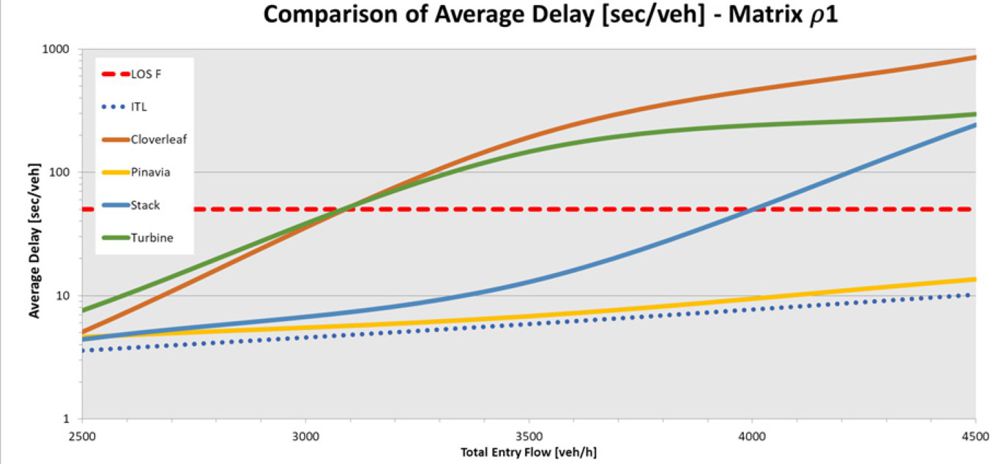
In this paper we focused on Delay, Average Speed and Distance Travelled. We analysed one traffic distribution test matrices (Table 2): ρ1 (1/3 of entry traffic crossed the intersection, 1/3 turned left and 1/3 turned right). Performance measures should be sensitive enough to differentiate between analysis scenarios and therefore we used three different load scenarios (2500 veh/h, 3500 veh/h and 4500 veh/h). The fleet composition included in the highway network reflects most common composition on the Highways including passenger cars (90%) and heavy good vehicles (10%).
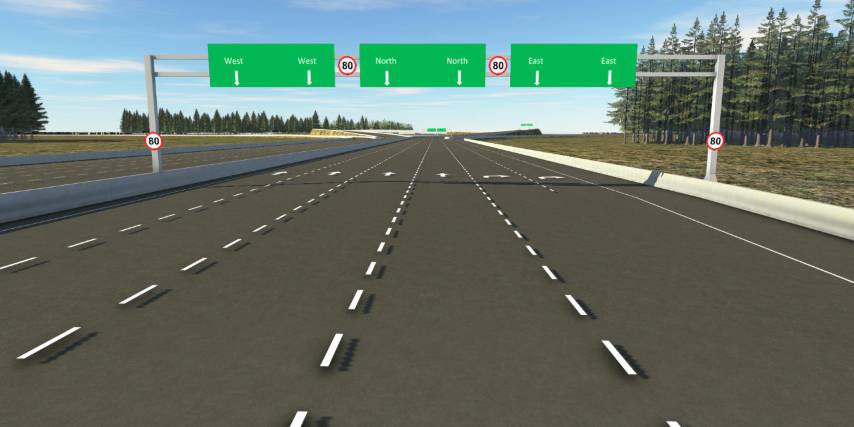
Results
The results of traffic simulation are shown in Table 2. At lower volumes (2500 veh/h) the performance is almost identical for all interchange designs. For middle volume (3500 veh/h) Cloverleaf and Turbine interchange designs are already over congested with Average Delays higher than 140 s/veh. The Average speed drops below 40 km/h in Cloverleaf and 46 km/h in Turbine design.
For highest volume traffic scenario (4500 veh/h) only ITL and Pinavia Interchange can throughput the demand with slightly lower delay of ITL; 10,2 s/veh than Pinavia: 13,6 s/veh. Total Delay time of ITL is 25% lower than Pinavia (51 hours vs 68 hours) and the travel distance of ITL is 3,6 % less than Pinavia.
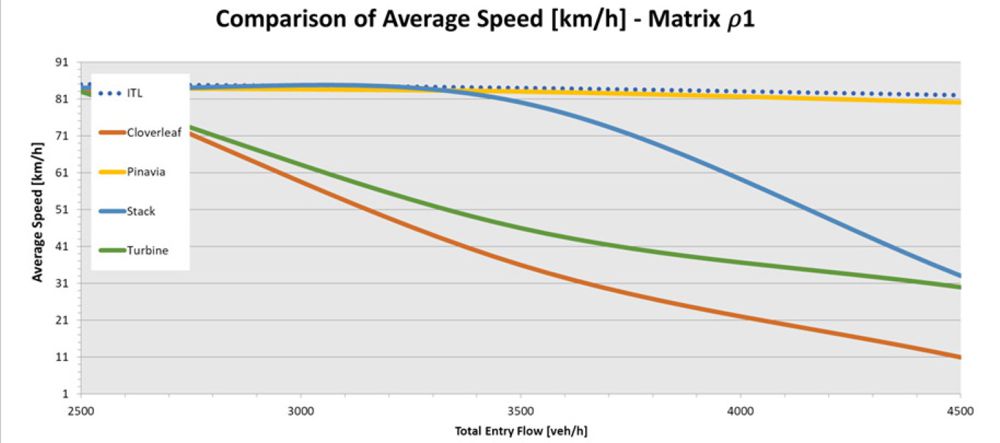
Some measures may not be clearly understandable to the reader of this paper and therefore additional explanation is provided. If we compare Dist. Total (km) in Table 3 for the ITL and Turbine design, there is much less distance travelled for Turbine design, which can lead to misunderstanding that this design has much better performance. In the sum of this measure there are all vehicles that are in the network or have already left it. For Turbine, volume scenario 4500 veh/h, the performance of Average Delay is very high (295,8 s/veh) and therefor many demands are not served and as result much less Total kilometres travelled.
| ITL INTERCHANGE | CLOVERLEAF | PINAVIA | STACK | TURBINE | |||||||||||
| 2500 | 3500 | 4500 | 2500 | 3500 | 4500 | 2500 | 3500 | 4500 | 2500 | 3500 | 4500 | 2500 | 3500 | 4500 | |
| Delay Avg. (s) | 3,6 | 5,9 | 10,2 | 5,1 | 193,3 | 859 | 4,6 | 6,8 | 13,6 | 4,4 | 12,9 | 243,2 | 7,6 | 147 | 295,8 |
| Speed Avg (km/h) | 85 | 84 | 82 | 84 | 36 | 11 | 84 | 83 | 80 | 84 | 80 | 33 | 83 | 46 | 30 |
| Dist. Total (km) | 39906 | 55663 | 71506 | 41691 | 46541 | 29304 | 41273 | 57732 | 74143 | 39468 | 54989 | 56486 | 42260 | 51430 | 46844 |
| Travel Total (km) | 471 | 667 | 879 | 496 | 1289 | 2760 | 490 | 695 | 927 | 469 | 687 | 1698 | 510 | 1129 | 1545 |
| Delay Total (h) | 10 | 23 | 51 | 14 | 751 | 2421 | 13 | 27 | 68 | 12 | 50 | 1045 | 21 | 534 | 1003 |
| Delay Total (h) | 10 | 23 | 51 | 14 | 751 | 2421 | 13 | 27 | 68 | 12 | 50 | 1045 | 21 | 534 | 1003 |
Conclusions
In this paper we analysed new type of ITL Interchange and compared with conventional designs Cloverleaf, Pinavia, Stack, Turbine.
ITL Interchange has proven to be a very good or the best choice in all benchmarks.
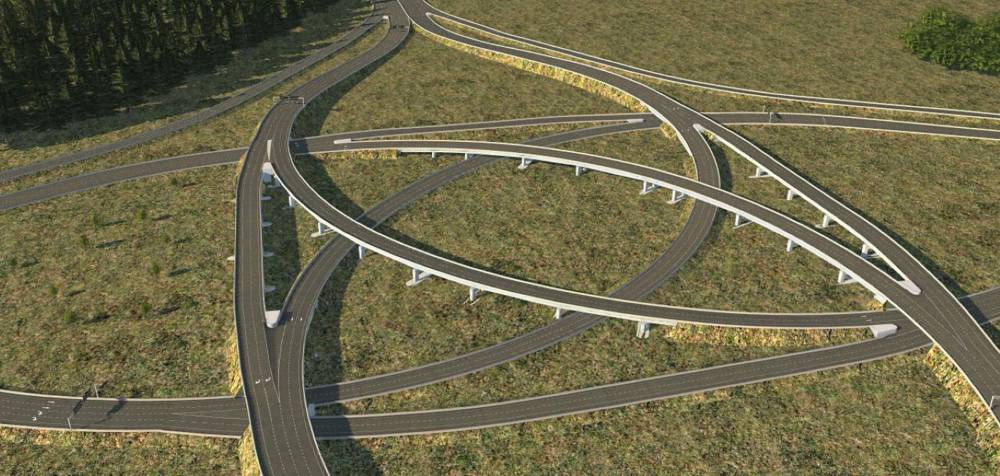
The geometry comparison concludes:
- The lengths of all ramps at other interchanges are 20-75 % longer than in the ITL Interchange,
- The lengths of all overpasses at other interchanges are from two to five times longer than in the ITL Interchange. In Stack-Interchange, the length of the overpasses is longer by the factor of 2,5, but it has a four-level construction,
- Overpasses incur the highest construction costs. In particular, the ITL Interchange is cheaper to build because it has a significantly lower length of overpasses than other interchanges. Maintenance is much cheaper.
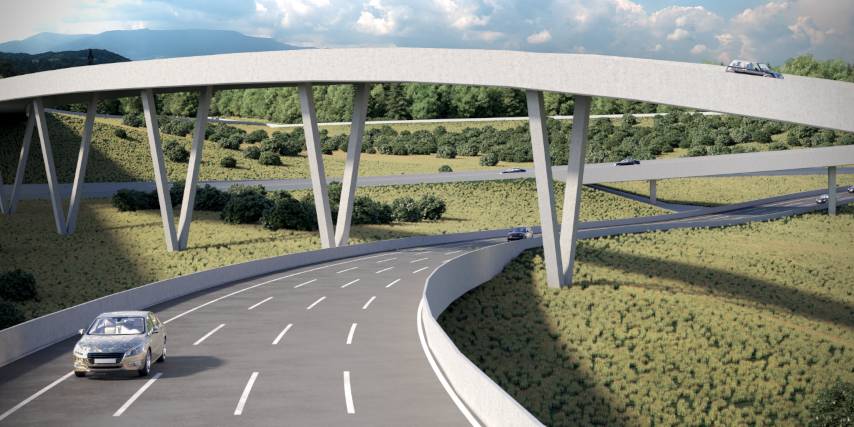
The following conclusions can be made from the Performance analysis:
- For higher traffic volumes (4500 veh/h), the ITL Interchange has better performance and offers much lower delays than conventional types like Clover, Stack and Turbine. Total Delay time of ITL is 25 % lower than Pinavia,
- For lover traffic volumes (2500 veh/h), the ITL Interchange has almost the same Average Delay (3,6 s/veh) than others (from 4,6 s/veh till 7,6 s/veh),
- Average Speed and Total Distance Travelled are much higher for ITL Interchange and it is slightly higher than Pinavia Interchange.

Article by Rafko Atelsek, ITL Interchange Team.











